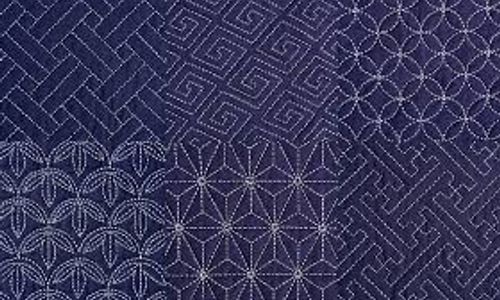Answers For Sashiko
Answers and detail explain for Sashiko
Explain
Sashiko

Good morning, everyone as you know, we're continuing with the part of the textile course where we look at some different types of stitching - or stitching techniques - and today we're looking at one that comes from Japan. 1It's called sashiko.
1Now, what does that word mean? Well, it translates as 'little stitches' and in its modern form, um, you can see from these pictures, it produces a very, er, very beautiful, decorative design on things like cushions, curtains and quilted covers - all produced by hand, of course - and many sold in shops these days. 2But sashiko began long ago, and its Japanese origins were much more functional than this.
It started among farming communities, in mountain villages, in the north of Japan's main island Centuries ago, transport was difficult in these places, and 3the bitter climate made it hard to grow fibre plants for spinning and weaving into warm cloth. Also, there were no sheep in Japan at this time, so, er, no wool ether, and this meant that people were left with a locally produced material, called asa, that was hard-wearing but not very warm. 4So, what they did was to dye this local fabric blue - because the dye was thought to strengthen the fibres - and they solved the problem of warmth by stitching together many layers of this cloth. In this way, they produced clothes that were warm but not too bulky. It was done, er, with a white, heavy thread, urn, so there were many shades of blue cloth - light and dark - and white stitching, and so a typical 'look' or image was created... like this. 5They used designs based on traditional Japanese patterns that had their own names, such as 'sea wave' perhaps to reflect the wavy effect of the design. Here's another example.
Now, each garment that was made at this time was planned for a specific purpose. So, for example, waistcoats were heavily stitched on the back and shoulders if they were going to be worn while carrying heavy baskets. And it wasn't only country people who relied on sashiko clothing. 6In Japanese towns, firemen dressed for duty in sashiko-stitched garments - jackets, trousers, hoods and gloves - which were soaked with water to protect them
So the point here is that sashiko clothing was essential for survival at one time. And even though making things in this way took up many hours for people who also had to work, do household tasks and so on, it was a vital skill.7 The wife of someone like a farmer, for instance, had to spend time making clothes, and she would do the stitching without a frame or structural support. And the garments, once you put them on, were flexible and moulded themselves to the wearer. If you look at a genuine sashiko garment today, then you can see the evidence of wear and get a feel for the shape of the wearer's body, which is fascinating
8Then, in 1895, traditional life changed, and sashiko was no longer necessary because rail travel reached northern Japan, and warm textiles could then be imported. However, since the 1970s, sashiko has been revived in Japan and has also been taken up by quilters and embroiderers in the USA and the UK. 9Nowadays, the designs are a little different. There are vertical and horizontal stripes, for example, or the stitches can be arranged to produce a diamond effect... here we are. Similar fabrics to those used traditionally can be found in modern furnishing or dressmaking departments or from suppliers so that the traditional appearance of a sashiko item has been maintained.
Now, there are exhibitions of ancient sashiko items, but the disappointing thing is this. 10While old pots and ceramics are considered to be treasures and preserved, even with cracks, ancient garments made by poor village women have not been given such a high value... and, sadly, many of them have been thrown away, rather than getting the attention of collectors. This is a pity because they say a great deal about how people once lived and about their technical skill... and it's no coincidence that sashiko has now become a pastrami on an international level.
Questions 1-10: Complete the sentences below. Write NO MORE THAN TWO WORDS for each answer.
The word sashiko means ' 1 (little stitches) .'.
In the beginning, sashiko was 2 (functional) rather than decorative.
In the past, warm fabrics such as 3 (wool) were not available in some parts of Japan.
Warm clothes were produced by using sashiko to join 4 (many layers | layer) of material.
Traditional sashiko designs included one called “5 (sea wave) ”
In the towns of ancient Japan, workers such as 6 (firemen | fire men) wore sashiko garments.
It used to be essential for someone married to a 7 (farmer) to know how to do sashiko.
Sashiko was not needed when 8 (rail travel) began in northern Japan.
Modern sashiko patterns include stripes and 9 (diamond) shapes.
Unfortunately, 10 (collectors) are not as interested in old clothes as in other ancient craft objects.
![[Forecast Q2-2025] - Biology lecture](https://static.helik.app/reading/8fd3d7d2-ccf9-47a3-8920-2e7a3b0d6607)
![[Forecast Q2-2025] - Living in the City](https://static.helik.app/reading/1a60bcf3-f3a7-4e9b-97a2-94d156a0de3b)
![[Forecast Q2-2025] - Student Union](https://static.helik.app/reading/fb443123-8c1d-447e-8c79-5a01650f4754)
![[Forecast Q2-2025] - Fruit-picking Job in an Orchard](https://static.helik.app/reading/e1968346-6c55-44ae-b8d3-f6a4fb7207b9)
![[Forecast Q2-2025] - University Crime Prevention](https://static.helik.app/reading/bdda593e-16d6-4c72-8a12-b116e917b27c)
![[Forecast Q2-2025] - Business Course](https://static.helik.app/reading/3308e282-99a6-4bcb-9d22-0b488701d968)
![[C20T1] - Choosing a restaurant](https://static.helik.app/reading/e9b21123-c43c-42fb-88b7-5d0be3a37e03)
